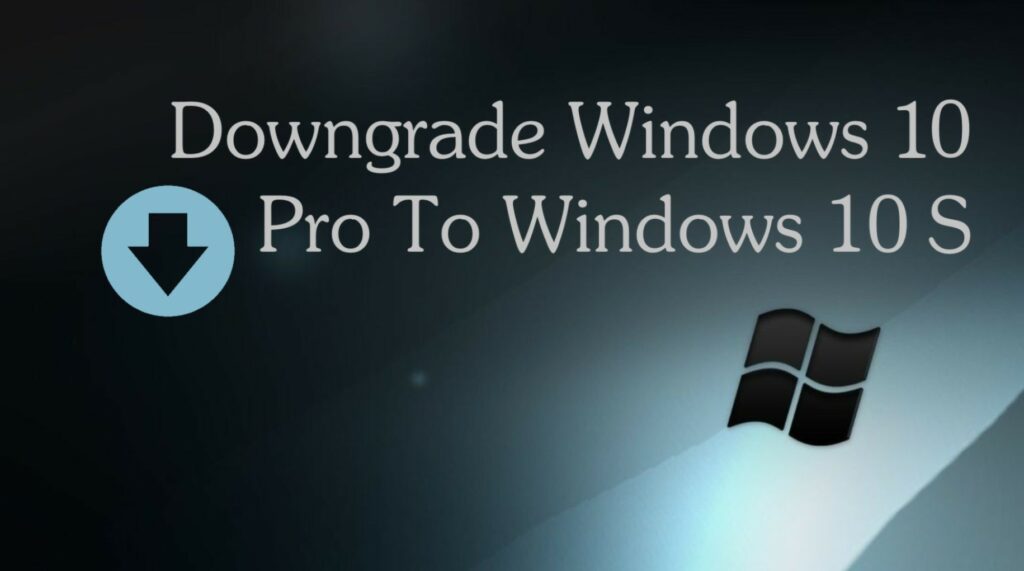A Comprehensive Guide on Downgrading from Windows 10 Pro to Windows 10 S

Introduction:
The digital landscape constantly evolves, and with it, users seek flexibility in adapting their operating systems to meet specific needs. Windows 10 Pro and Windows 10 S represent two distinct versions of Microsoft’s operating system, each designed with different priorities in mind. While Windows 10 Pro offers advanced features and customization options, Windows 10 S focuses on security, simplicity, and streamlined performance. In this comprehensive guide, we will delve into the intricacies of downgrading from Windows 10 Pro to Windows 10 S, exploring the steps involved and the implications of such a transition.
Understanding Windows 10 Pro and Windows 10 S:
Before embarking on the downgrade process, it’s crucial to understand the fundamental differences between Windows 10 Pro and Windows 10 S.
- Windows 10 Pro: Windows 10 Pro is a robust and feature-rich edition designed for power users and businesses. It offers advanced security features, greater customization options, the ability to join domains, and compatibility with a wide range of applications.
- Windows 10 S: Windows 10 S, on the other hand, is a streamlined version focused on simplicity, security, and efficiency. It operates within a more controlled environment, restricting app installations to those sourced from the Microsoft Store. This limitation enhances security and ensures a more stable user experience.
Step 1: Evaluate the Need to Downgrade:
Before proceeding with the downgrade process, assess your specific needs and whether the limitations of Windows 10 S align with your usage requirements. Consider factors such as app compatibility, security concerns, and the extent of customization you desire. Downgrading to Windows 10 S is a significant decision, and ensuring it meets your needs is crucial.
Step 2: Backup Important Data:
Any significant operating system change carries inherent risks, including data loss. Before initiating the downgrade, it is imperative to back up all essential data. Create a comprehensive backup of your files, documents, and any other crucial information to prevent potential data loss during the downgrade process.
Step 3: Obtain Windows 10 S Installation Media:
To downgrade from Windows 10 Pro to Windows 10 S, you will need the installation media for Windows 10 S. This typically involves creating a bootable USB drive or obtaining an official Windows 10 S ISO file. Microsoft provides tools to create installation media on their official website.
Step 4: Perform a Clean Installation:
Downgrading to Windows 10 S requires a clean installation, meaning that all existing data on your device will be erased. Ensure that you have backed up all essential data before proceeding. Insert the bootable USB drive or use the ISO file to initiate the Windows 10 S installation process.
Step 5: Follow Installation Prompts:
As you proceed with the Windows 10 S installation, follow the on-screen prompts carefully. Select the appropriate language, time, and keyboard input, and then choose the installation location. Be aware that this step will erase all data on the selected drive.
Step 6: Configure Windows 10 S Settings:
Upon completing the installation, you will be prompted to configure Windows 10 S settings, including creating a user account and customizing preferences. Follow the setup wizard, entering the required information to establish your new Windows 10 S environment.
Step 7: App Installation and Store Limitations:
Windows 10 S limits app installations to those available on the Microsoft Store, ensuring a more secure and controlled experience. Review the Microsoft Store for available applications and ensure that the apps you rely on are compatible with the Windows 10 S environment.
Step 8: Adjusting to Windows 10 S Restrictions:
Windows 10 S imposes certain restrictions to enhance security and stability. It is crucial to adapt to these limitations, which include the inability to install apps outside the Microsoft Store and the use of Microsoft Edge as the default browser. Familiarize yourself with these restrictions to maximize the benefits of the Windows 10 S environment.
Step 9: Considerations and Challenges:
It’s essential to acknowledge that the transition from Windows 10 Pro to Windows 10 S may present challenges. Compatibility issues with certain applications, the need to adapt to a more restricted app ecosystem, and potential feature limitations should be carefully considered. Evaluate whether the advantages of Windows 10 S align with your computing needs and if any sacrifices are acceptable.
Conclusion:
Downgrading from Windows 10 Pro to Windows 10 S is a significant decision that requires careful consideration of your computing needs and preferences. By following the comprehensive guide outlined above, you can navigate the process of creating installation media, performing a clean installation, and configuring Windows 10 S settings. Understand the limitations and advantages of Windows 10 S to make an informed decision about whether this streamlined version aligns with your goals. Ultimately, the choice between Windows 10 Pro and Windows 10 S should be based on your specific requirements, balancing customization options with security and simplicity in the digital landscape.




